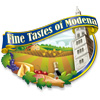Tigelle
The Crescentina Or Tigella Of Modena
The Crescentina is a small round bread typical of the Modena Apennines. For many the Crescentina is now called Tigella; named after the instrument once used for cooking the Crescentina.
The Tigella was a disc made from a high-heat resistant clay stone. Everything was crushed, mixed together and shaped like a disc. The disks were then baked and hardened in the embers of the fireplace. Often Tigelle had an incision, usually a six-pointed star; but in the noblest families the incision was the family crest.
The Crescentina was originally food made by the poor and therefore had very simple ingredients: flour, water, milk, eggs, salt and yeast. These ingredients were mixed together to make the dough. The dough was let to rise and then cut into the form of small discs with a diameter no bigger than 8 cm or slightly more than 3 inches.
The Tigelle (stone disks) were placed on the embers in the fireplace and when they became hot, a chestnut leaf was wrapped around a Crescentina and placed between two Tigelle. Others were made and placed upon the previous ones making a stack of Tigelle and Crescentine. The chestnut leaves were used to give the Crescentina flavor and to keep it moist.
This also became a family get-together where the whole family would gather in front of the fireplace until the Crescentine were ready to eat. During the winter, the Tigella (stone disk) would be heated, wrapped in a wool cloth and used as bed warmers.
Today people refer to Crescentine as Tigelle. Grill presses are now used to cook the Crescentina instead of the stack of stones. The way to eat Tigelle is to cut it open in half and stuff it with various types of cured meats and cheeses. But the best and traditional way to eat Tigelle is to spread lard and a generous sprinkling of Parmigiano Reggiano between the two hot slices. The lard is usually mixed with pancetta, rosemary and garlic.
The Crescentina for many years was bread for the people of the Modena Apennines which is now a culinary tradition for the entire population of Modena.
 Fine Tastes of Modena
Fine Tastes of Modena
follow us on: